| |
Expressionism was a modernist movement, initially in poetry and painting, originating in Germany at the beginning of the 20th century. Its typical trait is to present the world solely from a subjective perspective, distorting it radically for emotional effect in order to evoke moods or ideas. Expressionist artists sought to express meaning or emotional experience rather than physical reality. |
| |
Wikipedia |
The Cabinet of Dr. Caligari [Das Cabinet Des Dr. Caligari.] is now so famous a film title, so ingrained into cinema lore, that it never occurs to us that it actually sounds like an article from Furniture Monthly, if, indeed, such an organ exists (I'm guessing it does). It is, in that sense, an unassuming title, one that reveals next to nothing about the film it headlines. Yet the mere fact that this is the title gives it an automatic air of mystery. After all, you don't call your film The Cabinet of Dr. Caligari unless there's something damned interesting about the cabinet in question, and by association its owner. And believe me, there's something very interesting about this cabinet and the man it belongs to.
As directed by Robert Wiene, the film has an unsettling and oddly dreamlike air from its opening shot. There's nothing dramatic about it, just two men sitting in a garden conversing. But something clearly isn't right here. The men appear to be almost encased by a cage of long leafless twigs, and the wide-eyed and worried-looking older of the two talks of spirits that have driven him from his home and his family. When a woman glides by them in a trance, the younger man, Franzis (Friedrich Fehér), tells his companion that she is his fiancée. "What she and he have lived though is stranger than what you have lived through," he assures him. It all started at the annual fair in the little town in which he was born...
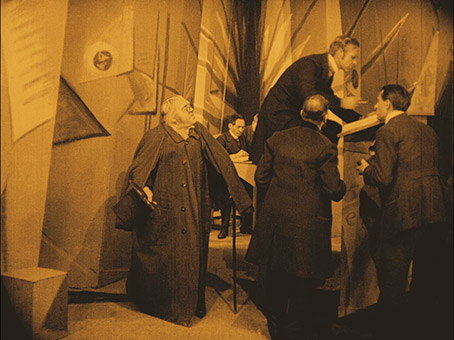
And so begins the flashback that makes up the bulk of the film's narrative, one that includes a number of scenes to which our storyteller could not have been privy. In the first, the Dr. Caligari of the title (a superbly sinister Werner Krauss) is seeking a permit from the foul-tempered Town Clerk to present an exhibit at the fair. A short while later he's outside his tent and barking up business for his very particular sideshow. What could it be? I'm glad you asked. Propped up inside a coffin-like cabinet on a stage in front of a gathered group of the curious is a black-dressed somnambulist. Not a commonly heard term in this day and age, a somnambulist is generally defined as someone who walks in their sleep. This one, named Cesare (a splendid Conrad Veidt), would have little option, since he has apparently been asleep for most of his life, but when awoken he knows every secret and can predict the future. In order to demonstrate this talent, Caligari rouses Cesare and invites the onlookers to test him. In the audience is Franzis and his close friend Alan (Hans Heinrich von Twardowski), who immediately rushes forward and asks the one question I'd never ask anyone with such an ability: "How long will I live?" "Till the break of dawn," the somnambulist portentously replies. An easy claim to dismiss, you might think, but there's a murderer on the loose and who knows where he might strike next?
It turns out that Franzis and Alan are rival suitors for the affections of the lovely Jane (Lil Dagover), who is soon to decide which one of the two she will marry. Whomever she choses, the two men pledge, they will remain friends afterwards, good intentions that are scuppered when Alan is murdered in his bedroom that night. Severely shaken by the death of his friend, Franzis enlists Jane's help to investigate Caligari, who quickly finds other work for his shadowy sleepwalker.
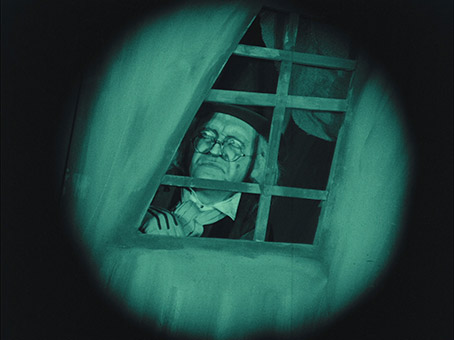
Intriguing though the storyline is, particularly for a film with so few cinematic precedents (Paul Wegener and Henrik Galeen's 1915 Der Golem is the only title that comes instantly to hand, and that's a lost film), it's the execution that has earned The Cabinet of Dr. Caligari its seat in the royal box of film history. Even today the look of this film is genuinely startling – watching Caligari is a little like attending a retrospective exhibition of German Expressionist art, swallowing a small dose of reality altering drugs, and falling headlong into one of the paintings. There are no sets in the traditional sense, but physical outlines of buildings and their interiors whose features have been painted onto the floors and backgrounds. And these are not the sort of buildings or rooms that you're likely to have encountered anywhere in the real world. I'm sure I saw no more than four or five straight vertical or horizontal lines anywhere in the film – everything from windows and walls to houses, caravans and even chairs are sharply and impractically angular. Even the light that is painted directly onto the walls and floors in an approximation of how it might fall through such windows and doors. This is a world pulled out of troubled dreams and redrawn by cubists, an externalisation of anxiety and fear so powerful that it has distorted the landscape.
The effect is extraordinary, imbuing every scene with a palpable sense of unease and (initially) inexplicable threat and creating a world in which the safety barrier of logic may well not apply. This carefully crafted air of artificiality is enhanced by the design-driven decision to film each scene from only one or two specific angles, shots whose mise-en-scène is every bit as crucial as the action that takes place within it. Take another look at that definition at the top of the review. The impact of Expressionism can be keenly felt throughout early German and even Hollywood cinema and its legacy lingers to this day. But nowhere will you find a purer cinematic representation than The Cabinet of Dr. Caligari, a sublime marriage of avant-garde and narrative cinema in which almost every shot is a gallery piece in its own right.
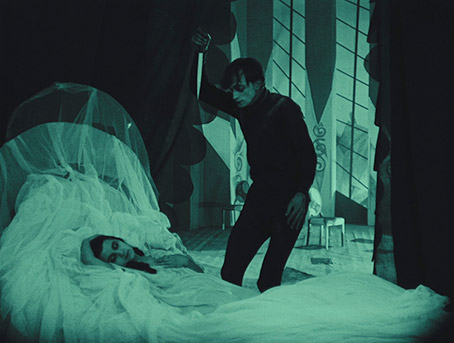
With all copies of J. Searle Dawley's 1910 Frankenstein and the aforementioned 1915 Der Golem now lost to history,* Caligari is free to stake its claim as the film that effectively gave birth to the horror genre, pre-dating Murnau's Nosferatu by two years. Its influence on subsequent genre works on both sides of the Atlantic has been well documented, and can even be clearly seen in more recent films such as Henry Selick and Tim Burton's The Nightmare Before Christmas and Guy Maddin's Careful. Elsewhere it sets precedents for genre films to come. The scene in which Cesare breaks into Jane's bedroom and carries her off is instantly recognisable from any number of Frankenstein and Dracula films, while the image of Cesare being woken and walking slowly and mechanically forward, observed with obsessive eagerness by the wild-eyed Caligari, plays almost like a template for the scene in Metropolis where Rotwang first activates the Robot Maria.
Others are more qualified to talk about the film as a commentary on life in post-WW1 Germany and its reading as an anti-authoritarian tract, but just about everyone seems to have an opinion on the framing story and how to interpret the final scene. I'm not about to go on a spoiler binge, but will suggest that the sequence is open to at least two very different readings and that the commonly held view (oh I so want to get into this) is nowhere near as clear cut as some have suggested. Speaking personally, the reading persuasively presented by David Kalat on his commentary track is not only more interesting but a lot more chilling, and adds to the sense that The Cabinet of Dr. Caligari was a film at least thirty years ahead of its time.
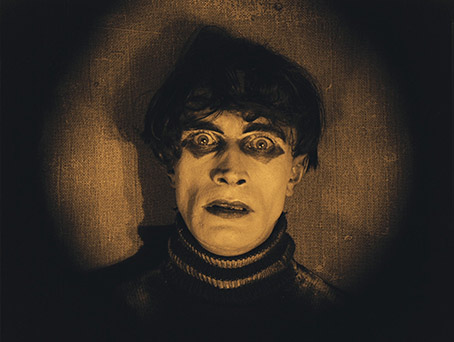
Watching the film again after many years and seeing it in such spanking condition also stirred in me a response I've not experienced for some considerable time. As the camera frames Cesare in facial close-up and he opens his eyes for the first time (even his black eye make-up is angular!), I was suddenly and unexpectedly transported back to a time when, for ninety mesmerising minutes, I really could believe that an Egyptian mummy could rise from the dead, or that a creature made from parts of dismembered corpses could be brought back to life. For just a few moments I was a child again, and able to enjoy that very unique chill that only old school black-and-white horror films were ever able provoke.
Before the film begins, there is a textual introduction outlining the challenges that the restoration team faced. The work, once again, of Friedrich-Wilhelm-Murnau-Stiftung in Wiesbaden, the restoration was made largely from the original camera negative, though as the first reel of the negative is missing, alternative sources were used for the opening scenes. A number of prints were sourced to replace a number of missing frames.
If you know Caligari from any of its previous home cinema incarnations or were lucky enough to see it on the big screen before this restoration was completed, you'll be aware of the condition the film had fallen into over the decades since its original release. As one of the restoration team says in the extra features, it fit the old picture we tend to have of silent films – the image jumped around in frame, it was littered with scratches, dust spots and damage, detail was obliterated in lighter areas darker areas, and there were frames missing throughout. By comparison, this new restoration is little short of astonishing. The image is rock solid, dust spots and damage have largely been eliminated, and the contrast has been balanced to reveal picture information that was previously invisible in the highlights, shadows and mid tones. The level of detail is impressive in places, although the colour tinting, although authentic to the release prints, does tend to take the edge of the sharpness a little when it's at its strongest, something common to almost all tinted monochrome films. The results still outstripped my expectations (and given who was responsible for the restoration, they were high), and when the tinting is light the results are striking.
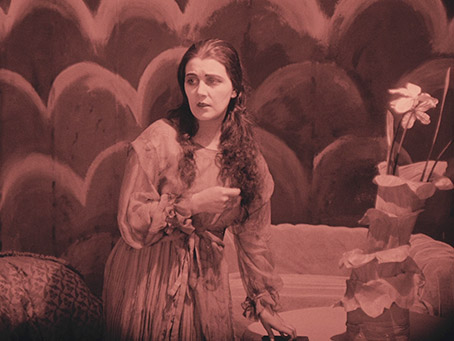
The sometimes moody music score, which is credited in the booklet to a number of composers, is available both in Linear PCM 2.0 stereo and DTS-HD Master Audio 5.1 surround. Both sound terrific, but the extra bass punch of the DTS on the lower frequencies really give this track the edge.
Commentary by David Kalat
There are not many people I can say this about, but when I load up a Masters of Cinema disc and see that there's a commentary by author and film historian David Kalat, my face lights up like a kid who's been handed a bucket of Smarties. Not only does Kalat really know his stuff, he's a hugely entertaining raconteur and is always brimming with enthusiasm for his subject. Check out his commentaries on the Masters of Cinema Mabuse DVD Box Set – his combined efforts there run for eight utterly enthralling pause-free hours. His contribution here is typically excellent and covers a sizeable amount of ground in the course of the film's 77 minute running time, including the development and production of the film itself, who was responsible for its unique look, its influence on Universal's gothic horror features and international commercial success, and a whole lot more. I was intrigued to discover that the film's love triangle grew out of the fact that scriptwriters Carl Meyer and Hans Janowitz were also in love with the same woman, an actress who at one point was slated to play Jane. Kalat also provides some interesting background on Weimar Germany, and gives a detailed breakdown of the thinking behind the Expressionist movement. And this is just a sampling of the subjects covered. A superb extra feature.
Caligari: The Birth of Horror in the First World War (52:53)
A German language documentary, directed by Rüdiger Suchsland, that provides a useful history lesson for those of us not that well versed in Germany's journey from the pre-WW1 Kaiser era to the Weimar Republic. There's a ton of fascinating archive film material and plenty of clips from the movies under discussion. Key art movements of the period are outlined, and specific information on Caligari and other German Expressionist films of the era is provided. Another damned fine extra.
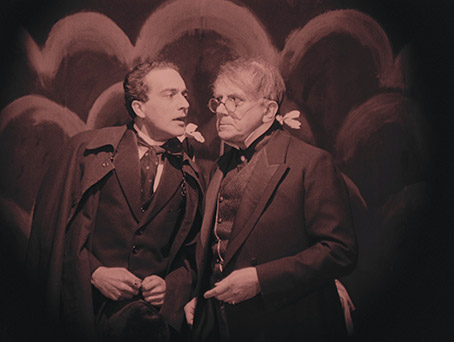
You Must Become Caligari (15:38)
Clips from the film are used to illustrate an enjoyable verbal essay by David Cairns, one that examines the various claims made about the origin of the film's distinctive style and explores specific elements of its narrative, characters and approach to storytelling. Interesting throughout, it also offers an intriguing alternative reading of the final sequence, which Cairns suggests actually starts earlier than you might think.
On the Restoration (8:47)
An extra feature of two distinct halves. The first is a handsomely photographed promo for the fine work done by the restoration team, one that concludes with a plea for public funding for their cause. The second begins by showing three stages of the restoration, then offers a welcome chance to compare shots from this new restoration side-by-side with its pre-digital 1984 equivalent. The improvements are significant, in picture stability, the clean-up of damage and dust spots, and particularly the tonal range, which brings out far more detail in darker areas and corrects previously burned out whites. Even the clarity of the Expressionistic intra-titles has been greatly enhanced.
Re-release trailer (1:29)
A solid enough hook for the restored version of the film.
Booklet
Another excellent MoC booklet whose centrepiece is a fascinating essay on the film by Lotte H. Eisener, which is joined by a contemporary Variety review (I genuinely didn't know it had been going that long), credits for the film, full credits for the restoration and even for the extra features, plus stills and the usual advice on how to set up your TV, which you should all know by now.
A genuine masterpiece of silent cinema and the grandfather of the psychological horror movie, The Cabinet of Dr. Caligari still astonishes almost a century after it was first released, and looks better here than I ever imagined I would live to see. A superb transfer is backed by a terrific collection of top flight extra features. A brilliant disc that comes enthusiastically recommended.
|